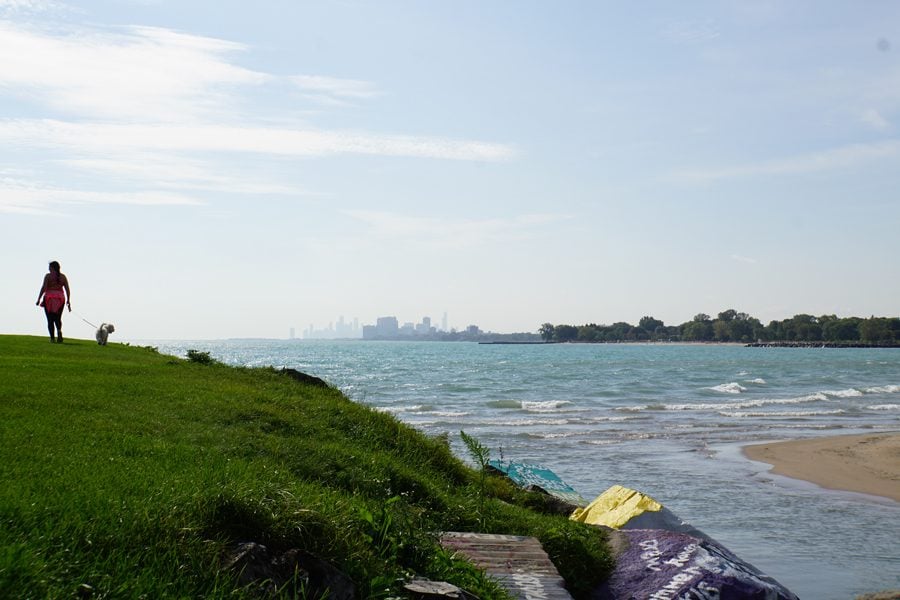Scientists examine Illinois earthquake risk
Owen Stidman/The Daily Northwestern
Northwestern’s Lakefill overlooking downtown Chicago.
October 6, 2019
On July 8, just after California experienced a 7.1-magnitude earthquake, the Illinois Emergency Management Agency issued a statement encouraging residents to prepare for possible local quakes. While Illinois has experienced over 600 recorded earthquakes, according to the 2018 Illinois Natural Hazard Mitigation Plan, officials and scientists continue to examine whether the state has a dangerous quake risk.
Illinois’ history is dotted with decently sized quakes. Bookended by two seismic zones on its eastern and southern border, the Wabash Valley Seismic Zone and the New Madrid Seismic Zone, the state has recorded 406 earthquakes magnitude 2.0 or higher since 1795, according to the mitigation plan.
A series of such earthquakes occurred in the New Madrid zone between 1811 and 1812, often considered some of the largest quakes since the country’s settlement by Europeans, according to the U.S. Geological Survey.
The quakes are estimated to have had magnitudes of over 7.0, and the USGS reports they had an area of strong shaking 10 times as large as the 1906 San Francisco earthquake. With the seismic history of this zone, some officials worry an Illinois earthquake with a similar magnitude to California’s could cause severe damages on large swaths of land.
Seth Stein, a professor in the earth and planetary sciences department at Northwestern, argues evidence points to a low major earthquake risk, and that the small quakes that southern Illinois experiences are just aftershocks of the 1811/1812 quakes.
“When you have an earthquake on the San Andreas fault, the two sides are moving,” Stein said. “That motion between the two sides rapidly wipes out the effects of the last earthquake. But in the middle of the continent, where nothing much is happening geologically, the biggest effect is still the earthquake from 200 years ago.”
Around 20 years ago, Stein said he used GPS receivers to analyze the ground in the New Madrid zone.
“The ground is not storing up any of the energy that will be released in a future earthquake,” Stein said. “That implies that there’s no good reason to believe there’s a big earthquake coming anytime soon.”
Stein still believes, though, that there is a moderate earthquake hazard for part of the state, but “nothing to lose sleep over.”
Stein adds it might be useful to adapt building codes in the southern part of Illinois to accommodate for earthquake risk, emphasizing a common saying in seismology: Earthquakes don’t kill people, buildings do.
However, northern Illinois doesn’t face any major risk of a dangerous quake, according to Stein. One of his previous classes did an analysis and concluded that the money Chicago residents spend anchoring their water heaters as earthquake protection, as recommended by the IEMA in its recent statement, would be better spent in the state lottery.
Douglas Wiens, a professor of earth and planetary sciences at Washington University in St. Louis, agrees that northern Illinois faces a low risk.
“A moderate level of concern would be appropriate for the southern part of the state, because there is some reasonable hazard of a magnitude 6-type earthquake that could damage buildings, especially buildings that are poorly constructed,” Wiens said. “But for the Chicago area, I don’t think that there’s much hazard. We can’t rule ever out earthquakes anywhere in the world, but the area around Chicago seems to be remarkably stable.”
Wiens recommends, though, that residents should have some preparation if they live right near the seismic zones, such as keeping emergency supplies if they live in a quake-prone area or having a plan if they get caught outside during a quake.
Residents who want a little more practice with an earthquake situation can participate in the Great ShakeOut, an international earthquake drill on October 17 at 10:17 a.m. Over two million people have registered in the central U.S., with over 18 million participating total.
Robert Bauer, an engineering geologist at the Illinois State Geological Survey who helps to coordinate this event, said the drill is designed to help participants figure out how to behave if there was an actual emergency.
“A drill imprints on your brain what to do, versus at the time kind of being lost,” he said. “If you’re outside the building, to move away from buildings or away from underneath power lines. If the shaking is really intense you want to get out and away from underneath trees. So you’re imprinting that.”
The Federal Emergency Management Agency also has a packet of other preparations residents can take to secure their homes from danger.
Email: [email protected]
Twitter: @emmaeedmund


